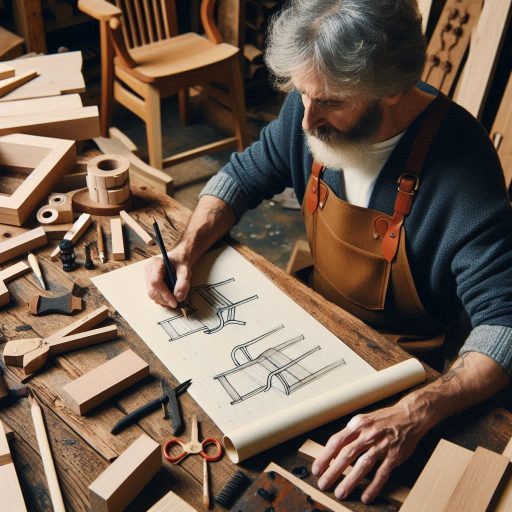Introduction
Finding your unique style as a furniture designer is crucial for achieving lasting success in the industry.
Your style reflects your personality, creativity, and vision, allowing you to express yourself through your designs.
A distinct style sets you apart from competitors in a crowded market, helping you stand out in a sea of similar offerings.
Clients actively seek designers who provide something different and fresh.
When your work resonates with potential customers, they are more likely to remember you.
A strong identity can lead to increased referrals and repeat business, essential components for a thriving career.
Moreover, a unique style encourages self-expression and innovation.
It empowers you to explore new ideas and push creative boundaries.
This exploration can lead to exciting designs that inspire others in the industry and elevate your work.
Ultimately, cultivating your unique style as a furniture designer can significantly enhance your career trajectory.
By embracing your individuality and showcasing your design philosophy, you connect with clients on a deeper level.
This connection not only attracts more clients but also fosters a fulfilling and successful design journey.
Explore different design styles
Finding your unique style as a furniture designer begins with exploring various design styles.
Researching design styles is crucial.
Familiarize yourself with the characteristics of each style to understand their nuances.
Modern design emphasizes clean lines, functionality, and a polished look.
Minimalist design focuses on simplicity and the elimination of excess, promoting a clutter-free aesthetic.
Rustic design embraces natural materials and a cozy, warm feel, often showcasing imperfections.
Each style offers unique principles and aesthetics that can inform your own design approach.
Research and Familiarize Yourself
Start by creating a list of styles that interest you.
Explore modern, minimalist, rustic, industrial, and Scandinavian designs.
Look for inspiration in magazines, online platforms, and design books.
Visit local furniture stores and showrooms to see these styles in person.
Pay attention to the materials, colors, and forms used in each design.
Observing real-life applications helps you visualize how these styles translate into actual furniture pieces.
Next, dive deeper into your research.
Explore the history and cultural significance of each style.
Understanding the origins of these styles can provide valuable insights.
It can help you appreciate their unique qualities and the emotions they evoke.
Look for key designers who have influenced each style.
Analyzing their work can spark your creativity and guide your exploration.
Consider how they approached design challenges and what made their work resonate with audiences.
Experiment with Different Styles
After gathering knowledge, begin experimenting with different styles.
Create sketches or mood boards that represent each design style.
Use tools like Pinterest or design software to collect images that inspire you.
Play with colors, materials, and shapes to see how they fit together.
Consider creating mock-ups or prototypes of your designs to test their feasibility.
Don’t hesitate to mix elements from different styles.
This experimentation can lead to innovative designs that reflect your personality and unique vision.
As you experiment, ask yourself key questions.
What emotions do these styles evoke? How do they resonate with your personal aesthetic?
Reflect on your design philosophy and what you want to convey through your work.
Identify the aspects of each style that speak to you.
This reflection helps clarify your unique design identity and guides your creative decisions moving forward.
Don’t be afraid to step out of your comfort zone.
Trying new styles can uncover hidden preferences and inspire new ideas.
Attend workshops or design courses that focus on different furniture styles.
Collaborate with other designers to gain fresh perspectives and insights.
Sharing ideas can inspire and challenge your creative process, helping you refine your skills.
Embrace the Journey
Ultimately, finding your unique style takes time and exploration.
Be patient with yourself during this journey of discovery.
Embrace the process of growth and learning.
Your unique style will emerge as you continue to explore and experiment.
Remember, each design style offers valuable lessons.
Use these lessons to craft your voice as a furniture designer.
Stay open to change and evolution in your design approach.
This openness will enrich your creative journey and help you find your niche in the dynamic world of furniture design.
Read: Building a Portfolio for Costume Design
Define your artistic inspiration
Defining your artistic inspiration is crucial for developing your unique style as a furniture designer.
Identifying the artists, architects, or designers who inspire you can significantly shape your creative direction.
Understanding their influence helps you refine your aesthetic and informs your design choices.
Take time to explore various artistic movements and individuals that resonate with you.
Look beyond furniture design to find inspiration in different fields, such as fashion, architecture, and fine art.
Identify Your Influences
Begin by creating a list of designers and artists who inspire you.
Consider their styles, techniques, and the emotions their work evokes.
Look for contemporary designers, historical figures, and even lesser-known creatives who capture your imagination.
Explore various design disciplines, from industrial design to graphic design.
This exploration will broaden your perspective and expose you to diverse influences.
As you compile your list, think about what draws you to each artist.
Is it their use of color, form, or materials? Perhaps it’s their approach to sustainability or their ability to tell a story through design.
Understanding these aspects will guide you in your creative journey and help you articulate your design philosophy.
Study Their Work
Once you have identified your influences, dive deep into their work.
Analyze the elements that resonate with you the most.
Look closely at their choice of materials, color palettes, and forms.
How do they balance aesthetics and functionality? Take note of the innovative techniques they employ and how they solve design challenges.
Consider the context in which they created their work.
Understanding the cultural and historical background can deepen your appreciation for their artistry.
Create a visual library of their designs.
Collect images, sketches, and articles that highlight their most impactful pieces.
This resource will serve as a reference for your projects.
Refer to it whenever you seek inspiration or guidance in your design process.
Analyze What Speaks to You
As you study the work of your chosen influences, reflect on how their designs speak to you.
What emotions do their pieces evoke? How do they align with your values and vision? Consider how their design philosophies relate to your own.
This analysis will help you define your unique artistic voice within the furniture design landscape.
Experiment with incorporating elements from your inspirations into your work.
Create mood boards that blend your influences with your ideas.
Allow yourself to reinterpret their styles through your lens.
This process will lead to innovative and personal designs that reflect your artistic journey.
Embrace Your Artistic Identity
Ultimately, defining your artistic inspiration is an ongoing process.
Your influences may evolve as you grow as a designer.
Stay open to new ideas and experiences that can shape your perspective.
Embrace the inspiration you draw from others while carving out your own identity.
This balance will enable you to develop a unique design style that resonates with both you and your audience.
By understanding your artistic influences, you will be better equipped to create furniture that reflects your vision and creativity.
Read: Famous Costume Designers in Hollywood
Incorporate personal experiences
Incorporating personal experiences into your designs can significantly enhance your uniqueness as a furniture designer.
Your personal history, travels, and cultural background provide rich sources of inspiration.
By drawing from these elements, you can create pieces that are not only visually appealing but also carry deep meaning.
Infusing your story and identity into your work can set you apart in a competitive industry.
Draw Inspiration from Your Personal Experiences
Begin by reflecting on your life experiences.
Consider significant events that have shaped your perspective and aesthetic.
Think about your travels and the places that have left a lasting impression on you.
Each destination can offer a different cultural influence that you can translate into your designs.
For example, a trip to a vibrant market might inspire the use of bold colors and patterns in your furniture pieces.
Alternatively, a serene landscape could lead you to adopt a more minimalist and calming aesthetic.
Your cultural background also plays a crucial role in shaping your design identity.
Explore your heritage and the traditions associated with it.
Look at the craftsmanship, patterns, and materials commonly used in your culture.
This exploration can provide you with unique ideas that resonate with your personal narrative.
Incorporating these elements into your designs helps you create furniture that tells a story and connects with others on a deeper level.
Infuse Elements of Your Own Story
Once you have gathered inspiration from your experiences, consider how to infuse these elements into your designs.
Start by identifying key themes or motifs that resonate with your personal journey.
This could include specific colors, shapes, or materials that evoke memories or feelings associated with your past.
For example, if a particular color reminds you of a childhood memory, consider using it in your furniture pieces.
This connection makes the design more meaningful and authentic.
Experiment with different techniques to integrate your story into your work.
This might include using handmade techniques or sourcing materials that reflect your heritage.
Crafting pieces that celebrate your background adds authenticity to your designs.
Additionally, consider sharing your story with potential clients.
Providing context about your inspiration can enhance their appreciation for your work.
Create Unique and Meaningful Designs
Creating designs that are both unique and meaningful requires vulnerability and openness.
Be willing to share your personal narrative and embrace the influences that have shaped you.
This authenticity resonates with others and creates a stronger connection between the designer and the audience.
Ultimately, your personal experiences and cultural background are invaluable assets in your design journey.
Embrace them as sources of inspiration and guidance.
The fusion of your story with your creative process will lead to furniture that reflects who you are.
Your designs will not only stand out but also resonate with those who encounter them.
By incorporating your experiences, you can craft pieces that inspire, tell stories, and leave a lasting impact in the world of furniture design.
Read: Essential Skills for Aspiring Costume Designers

Experiment with materials and techniques
Experimenting with materials and techniques is vital for furniture designers seeking to refine their unique style.
The materials you choose play a significant role in shaping the overall aesthetic and functionality of your designs.
By working with various materials, textures, and techniques, you can push your creative boundaries and discover new possibilities in your craft.
Try Working with Different Materials
Begin by exploring a range of materials available in the market.
Wood, metal, glass, fabric, and stone are traditional options, but don’t limit yourself.
Consider newer materials like reclaimed wood, sustainable composites, and biodegradable plastics.
Each material has distinct characteristics that can affect your design’s look and feel.
For instance, wood offers warmth and natural beauty, while metal can provide an industrial edge.
Visit local suppliers and showrooms to see materials firsthand.
Touching and experiencing materials helps you understand their textures and limitations.
Consider how different materials can be combined in your designs.
This blending can create striking contrasts and visual interest.
For example, pairing sleek metal with soft fabrics can produce a harmonious balance between hard and soft elements.
Transform Your Career Today
Unlock a personalized career strategy that drives real results. Get tailored advice and a roadmap designed just for you.
Start NowExplore Textures and Techniques
As you experiment, pay attention to the textures of each material.
Textures can add depth and intrigue to your furniture pieces.
Consider incorporating smooth, rough, glossy, and matte finishes.
Experiment with layering materials to create unique tactile experiences.
For example, combine a smooth glass surface with a rough wooden base to engage the senses and enhance your design’s appeal.
Additionally, try different construction techniques to expand your skill set.
Traditional woodworking methods, such as joinery and carving, can showcase craftsmanship.
Meanwhile, modern techniques like laser cutting and 3D printing can offer new avenues for creativity.
Each technique can alter the way materials are perceived and used in your designs.
Embrace these methods to find the ones that resonate with your vision.
Be Open to Unconventional Materials and Processes
Don’t shy away from unconventional materials or processes.
Sometimes, the most unique pieces emerge from unexpected sources.
Look for inspiration in everyday objects, industrial materials, or upcycled items.
For instance, using old bicycle parts in furniture design can result in a quirky yet functional piece.
Exploring non-traditional materials can challenge your creative instincts and lead to truly one-of-a-kind designs.
Experimentation requires a willingness to take risks and learn from failures.
Not every attempt will yield the desired results, and that’s okay.
Embrace these learning opportunities as valuable experiences that inform your future work.
Document your process, noting what works and what doesn’t.
This reflection will enhance your growth as a designer and refine your approach.
Ultimately, experimenting with materials and techniques is a journey of self-discovery.
Allow your curiosity to guide you as you explore new avenues in furniture design.
By being open to new ideas, you’ll uncover your unique voice and style.
This journey will enrich your creative process and enable you to create furniture that stands out in the marketplace.
Embrace the challenge of experimentation, and let it inspire your design evolution.
Read: Visual Merchandiser: Job Market and Opportunities
Develop a signature element
As a furniture designer, developing a signature element can significantly enhance your brand identity.
A signature element sets your designs apart and makes them instantly recognizable.
It creates a unique aesthetic that resonates with your audience.
This could be a unique color palette, a specific pattern, or a distinctive design motif that becomes synonymous with your style.
Establishing such an element helps you create a cohesive collection that reflects your vision and creativity.
Consider Unique Features
Start by exploring different aspects of your designs.
Reflect on what you enjoy most in furniture design.
Is there a particular color that inspires you? Do you have a favorite material that you consistently use?
Consider incorporating these elements into your work to create a signature look.
For example, if you love vibrant colors, develop a specific palette that defines your style.
Use these colors consistently in your pieces to establish visual continuity.
You can also explore unique patterns or textures.
Think about how certain patterns can evoke specific emotions or convey a particular message.
Integrating a signature pattern into your designs can create a strong visual identity.
This pattern could be geometric, organic, or inspired by cultural motifs.
Ensure that the pattern aligns with your overall design philosophy and aesthetic.
Create Distinctive Motifs
In addition to colors and patterns, consider developing distinctive design motifs.
This could be a unique shape, an innovative furniture form, or an interesting design feature.
For instance, you might create furniture with curved edges that set your work apart from others.
These motifs can help your designs stand out in a crowded marketplace.
They also provide a way for clients to recognize your work immediately.
Experiment with combining different elements to create your signature style.
For example, if you love minimalist designs but also appreciate rustic elements, find a way to blend these styles.
Your signature element could be a minimalistic piece that incorporates rustic textures.
This combination will showcase your versatility while establishing a recognizable brand identity.
Consistency is Key
Once you identify your signature element, maintain consistency across your designs.
This does not mean that every piece must look identical.
Instead, ensure that your signature element is subtly integrated into each piece.
This consistency reinforces your brand identity and helps build customer loyalty.
Clients will begin to associate your work with that unique feature, enhancing recognition.
Gather feedback from peers and clients about your signature element.
Their insights can help you refine and develop your unique style further.
Additionally, be open to evolving your signature element as you grow as a designer.
Trends and personal preferences may change over time.
Embrace these changes while staying true to your core identity.
Ultimately, developing a signature element is about embracing your unique voice as a designer.
It allows you to express your creativity and passion for furniture design.
Your signature element will help you carve out a niche in the industry.
It will also create a lasting impression on clients and peers alike.
Stay committed to refining your style and let your signature element guide you on this exciting journey.
Seek feedback and constructive criticism
To grow as a furniture designer, actively seek feedback and constructive criticism.
Sharing your work with others can provide valuable insights.
Engaging with peers, mentors, and potential clients helps you gain different perspectives on your designs.
Feedback is an essential part of the creative process.
It allows you to identify areas for improvement and enhances your understanding of your audience’s preferences.
Share Your Work
Start by sharing your designs in a variety of settings.
Consider showcasing your work in design forums, social media platforms, or local design events.
Platforms like Instagram and Pinterest are great for visual inspiration and interaction.
Share images of your projects along with a description of your design process.
Encourage viewers to provide their thoughts and reactions.
Networking is also crucial.
Attend design meetups and workshops to connect with other designers.
Use these opportunities to present your work and gather insights.
Engage in discussions about design principles and techniques.
This interaction can foster a sense of community and collaboration among fellow designers.
Consider reaching out to mentors who can offer valuable guidance.
Experienced designers can provide a wealth of knowledge based on their own experiences.
When sharing your work with them, be open to their insights.
Their constructive feedback can help you refine your style and approach.
Embrace Constructive Criticism
Embracing constructive criticism is essential for your growth as a designer.
Understand that feedback is not a personal attack; it is an opportunity for improvement.
Listen carefully to the critiques you receive.
Ask clarifying questions to better understand the suggestions being made.
This active engagement shows your willingness to learn and adapt.
Take notes on the feedback you gather.
Identify recurring themes or specific points that resonate.
This analysis can help you recognize patterns in your work that may need adjustment.
Use this information to inform your design decisions moving forward.
Additionally, create a feedback loop.
Regularly seek input on new projects and revisions.
Continuously engaging with others ensures you remain open to fresh perspectives.
It also demonstrates your commitment to refining your skills and style.
Consider forming a design critique group.
This group can consist of peers or colleagues who share similar goals.
Meeting regularly to review each other’s work fosters an environment of collaboration.
Constructive discussions can lead to valuable insights and inspire new ideas.
Use Feedback for Growth
Ultimately, use feedback as a tool for growth and refinement.
Each critique provides an opportunity to enhance your designs.
As you incorporate suggestions, you will notice an evolution in your style.
This journey of improvement is an integral part of becoming a successful furniture designer.
Stay open to change, and do not fear experimentation.
Seeking feedback and embracing constructive criticism will empower you to refine your unique style.
Remember, every piece of feedback is a stepping stone toward achieving your design vision.
The more you engage with others, the clearer your artistic voice will become.
By actively seeking input, you’ll strengthen your skills and confidence as a designer.
Stay true to your vision
As a furniture designer, staying true to your vision is essential for your creative journey.
While being open to feedback is important, trusting your instincts is paramount.
Your design vision reflects your unique perspective and creativity.
Embracing this authenticity helps differentiate your work from others in the industry.
Trust Your Instincts
Trusting your instincts can be challenging, especially when faced with criticism or differing opinions.
Remember that your intuition is informed by your experiences and research.
It is essential to filter feedback through the lens of your design philosophy.
When you receive input, consider whether it aligns with your vision.
If it does, adapt your work accordingly.
If it doesn’t, stand firm in your creative choices.
This process builds confidence in your design abilities and strengthens your brand identity.
In the furniture design world, trends come and go.
While it’s important to stay informed about these trends, don’t feel pressured to follow them blindly.
Trends often shift quickly, leaving those who chase them feeling lost and disconnected from their original vision.
Instead, focus on what truly inspires you and resonates with your design philosophy.
This approach will create timeless pieces that reflect your unique style.
Avoid Compromising Your Style
Avoid compromising your style to fit trends or please others.
Authenticity is key to building a recognizable brand in the competitive furniture market.
When you prioritize authenticity, your designs will resonate more deeply with your target audience.
Your work will speak to those who appreciate your unique aesthetic, leading to a loyal customer base.
Authenticity creates trust and allows your designs to shine.
Take the time to articulate your vision clearly.
Write down your design philosophy and the values you want your brand to embody.
This clarity will guide your decision-making process.
When faced with choices, refer back to your philosophy to ensure alignment with your vision.
This practice can help you stay focused and grounded, even in challenging moments.
Embrace Constructive Feedback
While it’s essential to trust your instincts, embracing constructive feedback can also be beneficial.
Listen to those who understand your vision and have valuable insights to share.
Constructive criticism can provide new perspectives and help you refine your work.
However, always weigh this feedback against your vision.
If the input feels authentic and resonates with your design principles, consider implementing it.
Seek feedback from trusted peers, mentors, or your target audience.
This external perspective can help you grow while remaining true to your core vision.
Balancing openness to feedback with steadfastness in your design philosophy is crucial for maintaining authenticity.
Cultivate Your Brand Identity
Ultimately, staying true to your vision will cultivate a strong brand identity.
Consistency in your design choices and philosophy will make your work recognizable.
Customers will appreciate your dedication to authenticity, leading to greater brand loyalty.
Embrace your journey as a furniture designer.
Trust your instincts and create designs that reflect your true self.
Your unique vision is what will set you apart in the ever-evolving world of furniture design.
Conclusion
Finding your unique style as a furniture designer is vital for standing out in a competitive market.
A distinct style reflects your personality, creativity, and vision.
It helps attract clients who resonate with your design philosophy.
Additionally, a strong identity can lead to increased referrals and repeat business.
Embracing your individuality allows you to explore innovative ideas and push creative boundaries.
This exploration results in exciting designs that inspire others in the industry.
By showcasing your unique perspective, you create a memorable brand that leaves a lasting impression.
Aspiring furniture designers should prioritize cultivating their unique style.
This journey involves self-discovery, experimentation, and a willingness to express personal creativity and passion.
Don’t shy away from what makes you different; celebrate it.
Your unique style is your greatest asset, setting you apart from competitors.
By embracing your individuality, you can connect more deeply with clients and enhance your career.
Remember, your design journey is a reflection of who you are.
Embrace it, and let your creativity shine through your work.
Transform Your Career Today
Unlock a personalized career strategy that drives real results. Get tailored advice and a roadmap designed just for you.
Start Now[E-Books for Sale]
The Big Book of 500 High-Paying Jobs in America: Unlock Your Earning Potential
$19.99 • 500 High-Paying Jobs • 330 pages
Explore 500 high-paying jobs in America and learn how to boost your career, earn more, and achieve success!
See All 500 High-Paying Jobs of this E-Book
1001 Professions Without a Degree: High-Paying American Jobs You Can Start Now
$19.99 • 1001 Professions Without a Degree • 174 pages
Discover 1001 high-paying jobs without a degree! Unlock career tips, skills, and success strategies for just $19.99!




